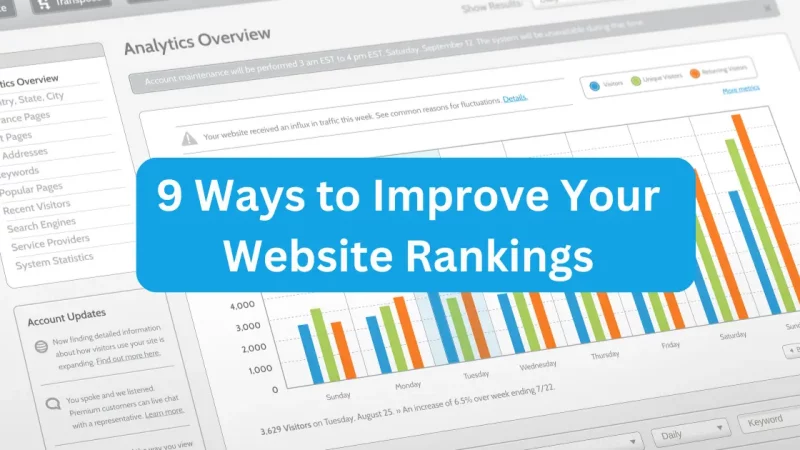
How to Improve Website Ranking? 9 Tips From the Expert (+ Bonus Tips)
Adam White
Posted on March 15, 2024
As a new website owner, one of the biggest concerns is whether the content you create will receive enough visibility or not.
Don’t worry, with the right approach and consistent effort, your content can reach a wide audience. If you’re new to SEO (Search Engine Optimization) or have limited experience with it, it’s completely normal and something that many newcomers face.
SEO has evolved significantly over time and continues to change as it progresses. As I write this, there is an ongoing Google Core March update (2024) that has intentionally pushed down AI-generated content to give high-quality, helpful content a better chance at visibility.
With that in mind, let’s discuss some essential yet straightforward ways to improve your website’s rankings and attract more visitors to your site.
9 Ways to Boost Your Website’s Search Rankings
In this section, we’ll outline several strategies that beginners can implement to help their websites gain better visibility and improve their search engine rankings.
1. Focus first on the user, then on search engines
The primary reason a user will visit your webpage is if it provides helpful and valuable information. You might be able to temporarily boost your search engine rankings using techniques, but if your webpage doesn’t satisfactorily answer the user’s query, it won’t maintain that high ranking for long.
Creating high-quality, user-focused content is and will remain the most crucial factor for success. Search engines prioritize web pages that help users find what they’re looking for.
Here’s a simple process you can follow every time to create helpful content. Use tools like Google Analytics to understand the important metrics you can observe about your audience on the website.
- Understand your target audience’s needs, pain points, and search intent.
- Structure your content in a way that is easy to read and navigate.
- Use examples, visuals, stats, and clear explanations to make complex topics more understandable.
- Provide actionable tips or solutions that readers can implement.
- Engage with your audience by encouraging comments and addressing their questions.
According to Hubspot, 83% of marketers believe it’s more effective to create higher-quality content less often. Adhering to this simple guideline before building any article will help your users read it till the very end & thus increasing engagement with your blog.
Keeping quality content over quantity is the way to succeed in 2024 and beyond. Remember at the end of the day search engine crawlers are still a machine and algorithms, they rate websites with the engagement time. The more engagement you can create, the better website rankings you can achieve.
2. Focus on long-tail keywords
When you’re just starting, it will be extremely challenging to outrank established websites for high-difficulty keywords. Keyword difficulty is a metric that measures how tough it will be for your content to earn a top ranking for a particular search term.
Instead, it’s advisable to target long-tail keywords with low difficulty scores as you begin building your online presence.
Long-tail keywords are search phrases that contain more than three words and are very specific. These queries have a clearly defined search intent and aim to address narrowly focused questions.
By targeting long-tail keywords, you can create content that directly answers the precise needs of searchers. This increases the likelihood that your pages will rank well for those terms and attract relevant traffic from users whose intent aligns with what your content offers.
While long-tail keywords individually receive less search volume than broader terms, collectively they make up the majority of web searches. Prioritizing these targeted phrases allows you to rank for a wide range of specific queries that bulk keywords cannot adequately cover.
But how to find them for your niche?
Serpple, an online tool for SEO can help you find those long-tail keywords with the difficulty metric we just discussed above.
It offers a 14-day free trial with any of the plans you choose.
Once you sign up, you will directly be taken to the dashboard. Click on the “keyword insight” as shown in the image
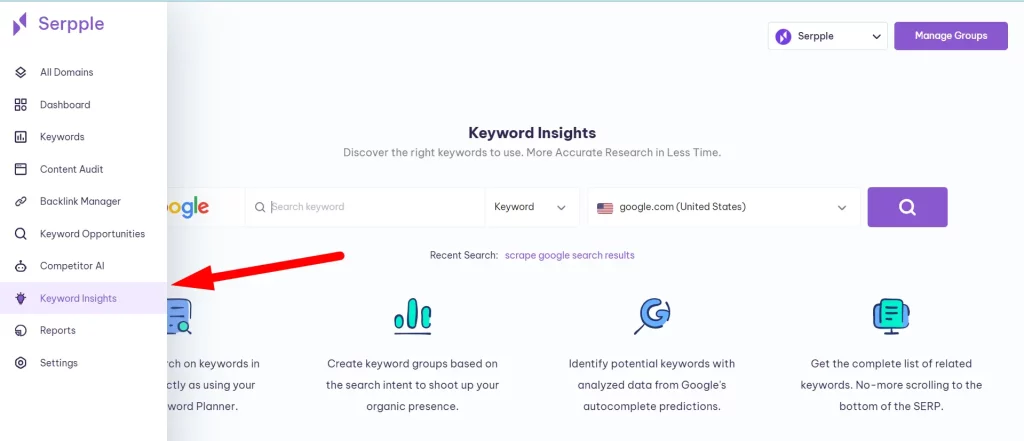
Here, you can type in your seed keyword, and select the country you want to target, and the tool will list out all the related keywords to the primary keyword you entered.
For our case, let’s choose our niche to be the cat food business in the USA.
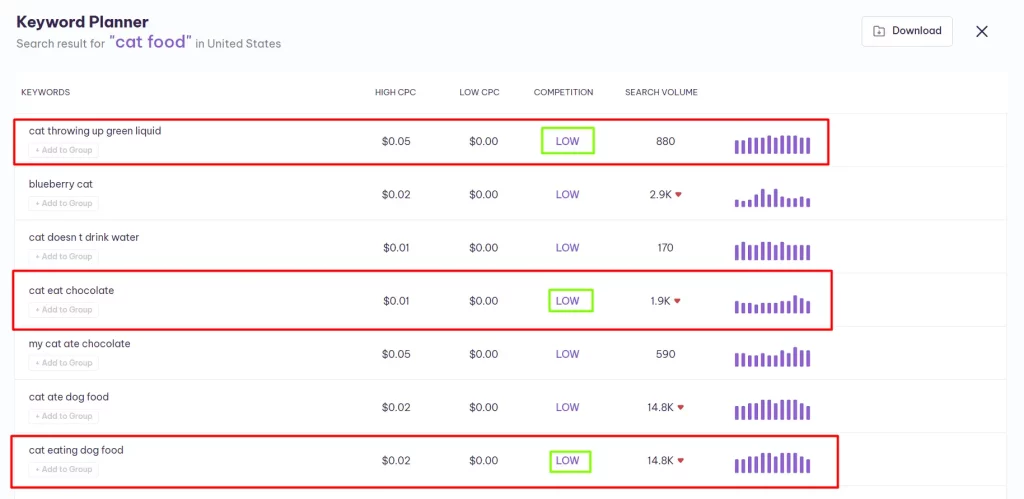
While scrolling through the keyword planner, you can find a lot of keywords that are low competition and have great search volume. Targeting these keywords can bring in a lot of traffic if you can rank higher in the search engines.
Once you are done with the low-competition keywords you can now then move onto the keywords with medium difficulty. However, building helpful content on those easy keywords is a work plan for quite 6-months. So, get ready and show your content skills and expertise!!
With that, let’s come to our next part which is proper content planning.
Read More: How To Find Low-Hanging Fruit Keywords for Your Website
3. Setup a content plan prior you writing a single-word
Now that you have identified low-competition, long-tail keywords to target using Serpple, you’re ready to start creating content. However, not every keyword will be equally valuable or relevant to your business, even if they have low difficulty scores.
Some topics and keywords may seem unimportant to your core offerings. For example, phrases like “seafood sensations” and “slimcat” would likely not be priorities for cat food business. It’s better to ignore keywords that stray too far from your business’s focus.
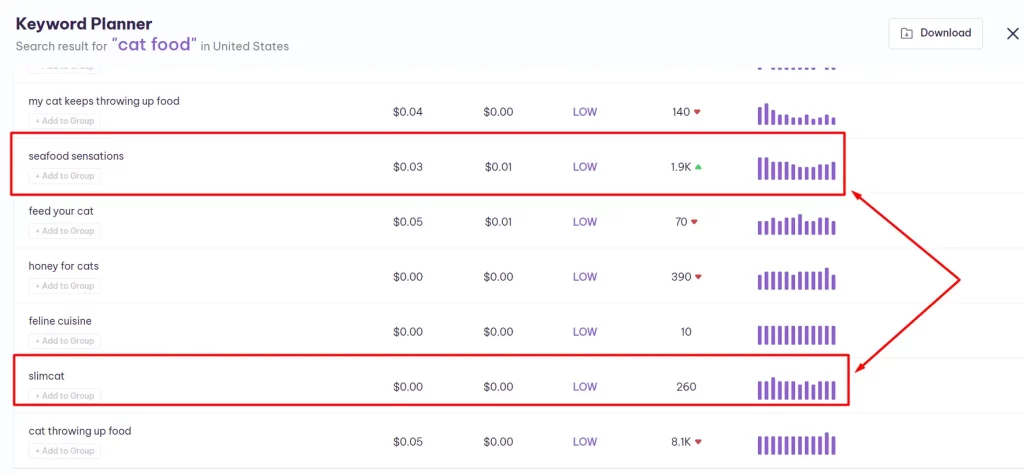
At the same time, there will be certain high-value keywords that should be prioritized from the start as part of your content marketing strategy. These terms directly relate to your products, services, or expertise areas that you want to be highly visible for in search.
This is where developing a comprehensive content plan becomes crucial. Map out all the topics, keywords, and content types you want to cover over the next quarter or six months. Prioritize the most important terms first, while sequencing other topics appropriately.
4. Build Relevant Backlinks
Backlinks remain a crucial factor in determining your website’s search engine rankings. They serve as a vote of confidence from other websites, signaling to search engines that your content is valuable and authoritative.
However, building relevant backlinks is challenging. In the real world, a doctor is more likely to know and get recommendations from other doctors rather than plumbers. Similarly, a doctor’s recommendation for another doctor carries more weight than one from an unrelated business owner. Google’s algorithms work comparably – if you’re popular and well-regarded within your industry, your website will gain more traction.
People trust recommendations from credible, relevant sources. Therefore, backlinks from authoritative sites within your niche or industry are far more valuable for improving your rankings in competitive markets.
To build a strong backlink profile, consider these general approaches:
- Create exceptional, in-depth content that naturally attracts links from other publishers who want to cite or reference your material.
- Identify influential bloggers, publications, and trusted directories relevant to your niche. Reach out for guest posting opportunities or listings.
- Leverage existing relationships and partnerships to get backlinks from companies/sites you collaborate with.
- Use tools to monitor your competitors’ best-performing pages and backlink sources as potential link targets. You can use serpple’s backlink manager, it is easy to use and effective.
There are many proven backlink-building strategies out there, but this subject goes far deeper than can be fully covered in this article. Let’s say you’re building an E-Commerce app platform. Then create content around features like secure checkout or real time inventory. This will help you boost your SEO by targeting the right keywords and audience. Quality matters far more than sheer quantity.
Quick Tip: Before manually building any new backlink, ask yourself – “Can I potentially get referral traffic from this website if I get a link here?” If the answer is yes, that’s an ideal link opportunity to pursue.
5. Get your website technically sound
When you’re just starting with a new website, getting the technical fundamentals right is crucial. One key factor is having a fast, responsive website that loads quickly for users. something that heavily depends on choosing a reliable web hosting provider. Nobody likes waiting around for pages to load these days.
Think about it – if Google took minutes just to return your search results, you’d likely look for a different search engine pretty quickly. The same applies to your website visitors – if it’s sluggish and slow, they’ll simply bounce away to a competitor’s site.
That’s why businesses looking to scale turn to enterprise website development. This ensures optimal performance, security, and scalability for a seamless experience across users and search engines.
The key is to keep your website lightweight by optimizing images for image SEO, leveraging browser caching, minifying code, and removing any unnecessary plugins or bloated elements that bog it down. Even a 1-second delay in load times can significantly impact bounce rates and conversions.
To further enhance performance, you should also compress image size to reduce loading time and improve user experience.
That’s where AccuWeb.Cloud comes in. It offers high-speed performance, reliable uptime, and advanced security to keep your site running at its best. A technically sound website with optimized servers, fast loading times, and secure hosting enhances SEO and improves the overall user experience as well.
For new website owners just getting started, here are some general tips to ensure a fast, technically sound website:
- Choose the best VPS hosting plan appropriate for your needs. Cheap, low-quality hosts can bottleneck your speeds.
- Implement a content delivery network (CDN) to distribute your site files across a global network for faster page loads from anywhere.
- Enable compression to minimize the file size of your HTML, CSS, JavaScript and other assets.
- Continuously monitor and optimize images by compressing file sizes and using next-gen formats.
- Use browser caching so returning visitors don’t have to re-download the same files.
- Minimize the use of third-party scripts, plugins, and embedded objects that can add excess bloat.
Having a fast website is important, but what if search engine crawlers can’t properly access and index your pages in the first place?
Google and other search engines use crawlers or bots to discover new and updated web pages. If your site has technical barriers preventing these bots from crawling, your pages won’t get indexed and displayed in search results.
Two common technical issues beginners face are:
- Being blocked by the robots.txt file
- Having “noindex” or “nofollow” directives implemented incorrectly
The robots.txt file acts as a set of instructions for web crawlers, telling them which pages they can and cannot crawl on your site. If configured improperly, it can inadvertently block Google from accessing your entire site.
Similarly, the “noindex” meta tag tells search engines not to index a particular page in results. While sometimes used intentionally, if implemented site-wide, it can cause your whole website to become unlisted.
As a new website owner, you’ll want to ensure:
- Your robots.txt isn’t disallowing crawlers from the entire site
- You don’t have any noindex tags unintentionally applied site-wide
- You allow search engines to crawl and index your most important pages
It’s a technical aspect that’s easy to overlook but critical for SEO. Even with a blazing-fast site, lack of crawling and indexing will make it impossible for your pages to get found in search results.
Quick Tip
If you have Google Search Console set up for your website, you can easily check which individual pages are being indexed or not. Within Search Console, navigate to the Coverage report to see any issues preventing full indexing.
Alternatively, you can use the “site:” search operator to check indexing directly in Google. Just search for “site:yourwebsite.com/page-url” replacing with your actual page URL. If the page is indexed, it will show up in the results.
You can also use the same tip to ensure that, if you are making any updates as part of your on-page SEO optimization, you can check whether Google has crawled your new update or not from Google search results.
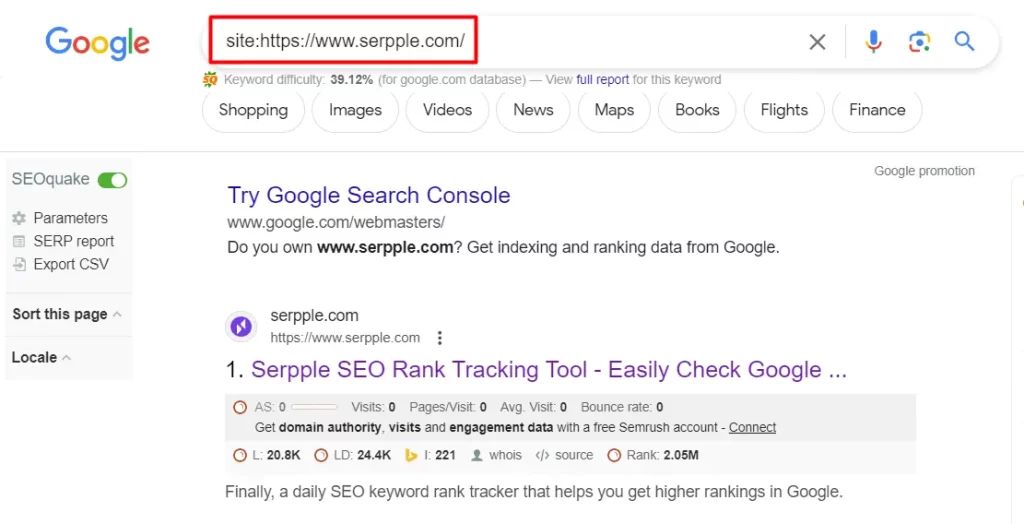
6. Prioritize Updating Existing Content Over Creating New
If you already have content published on your website but aren’t seeing a significant increase in traffic, it’s often better to focus on improving those existing pieces before creating brand new ones.
The content you’ve already published represents an asset that can continue driving traffic and conversions over time with some optimization. To identify which content needs a boost, go to Google Search Console and look for keywords where your pages are ranking in positions 10-25.
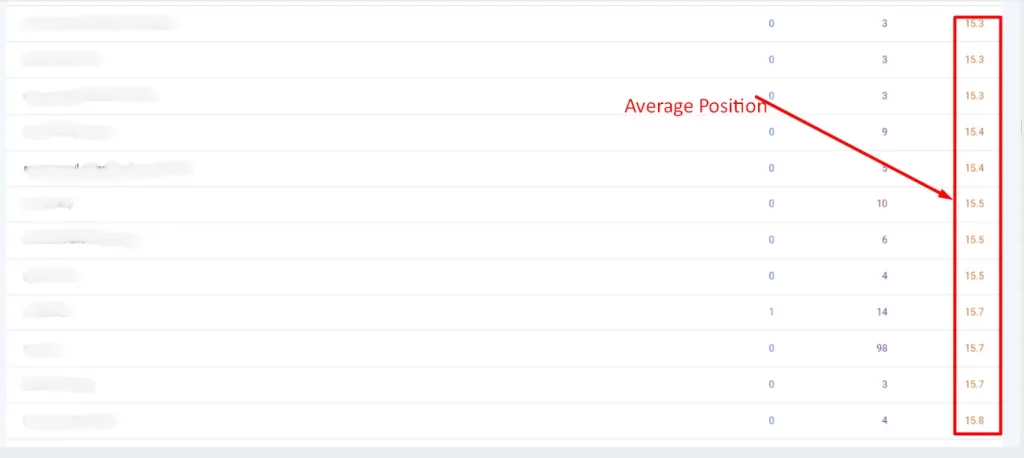
This is your best chance to get on top of the 5 results of Google since search engines are already considering you to be on the second page.
For those underperforming but promising keywords, look for those specific keywords and the top-ranking content. What are they doing particularly well? Look for opportunities to expand your content with additional details, visuals, or insights to make it more comprehensive and valuable.
Backlinks can also play a huge role, so examine the link profiles of the higher-ranking competitors. Make a list of the sites/pages linking to them. Attempt to get some backlinks to your content from those same sources as well. If you can’t get direct links, look for similar content on other authoritative sites in your niche and try acquiring links there.
The goal is to breathe new life into your existing content assets by making them more robust, and visually appealing, and bolstering them with high-quality backlinks. This refreshed content can then re-surface more prominently in search results for your target keywords.
Sometimes, the titles of your pages tell a different story than your overall page. Optimizing the meta data can help you to rank better on search engines. Keep in mind that your meta title and meta description should precisely convey what your page is talking about. Try to make them crisp and catchy.
7. Incorporate Videos to Enhance Content and Engagement
Video content is becoming increasingly dominant in 2024 and beyond. Consumers overwhelmingly prefer video for its ability to communicate information in an engaging, easy-to-understand format. If feasible for the topic, incorporating videos onto your pages can provide a significant boost.
Beyond just written text and images, videos allow you to connect with your audience through voices, motion, and visuals that textual content alone cannot match. This multimedia approach caters to different learning styles and makes your content more memorable and impactful.
It’s also especially useful for a secure virtual meeting, where dynamic content can help maintain attention and grow interaction in an otherwise static environment.
When planning to add videos, consider these best practices:
- Create video versions of your most popular blog posts/guides to reinforce the key points
- Use videos to walk through complicated step-by-step processes or product demonstrations
- Interview industry experts or customers to provide unique perspectives and experiences
- Optimize videos for visibility by using detailed titles, descriptions, transcripts, and closed captions
In addition to enhancing engagement, videos can also positively impact your SEO. A video-enriched page is likely to keep visitors on your site longer, reducing bounce rates. Search engines recognize this type of dwell time as a signal of high-quality, relevant content
Furthermore, after Google, YouTube is the second most widely used search engine. By uploading your videos to YouTube and optimizing them for relevant keywords, you can tap into an entirely separate stream of potential traffic.
Properly titled, tagged, and described videos that comprehensively cover topics your audience is searching for can rank prominently on YouTube itself. This allows you to get discovered by an engaged audience actively seeking out that video content.
It’s a win-win situation – your website benefits from the engaging videos embedded on your pages, while your YouTube channel can simultaneously drive newly interested visitors straight to your site from their video viewer.
Over time, as your YouTube videos gain more views and engagement, this can create a self-perpetuating cycle where your embedded site videos also receive more views. This visible popularity signals their relevance to search engines as well.
8. Utilize Structured Data for Enhanced Search Visibility
While not a direct ranking factor itself, implementing structured data for SEO (also known as schema markup) provides essential context about your web pages to search engines. This helps them better understand and accurately represent your content in search results.
Structured data uses a standardized format and vocabulary to explicitly label different elements on a page – from the main entity being discussed, to reviews, events, how-to instructions, FAQs, and more.
For users, this translates to richer, more informative search result listings that can increase visibility and click-through rates. For example, for a SaaS-based software company, we can show reviews and pricing of the product on rich results. Here is an example below:

Here is the list of supporting structured data that Google has to offer.
While a minor technical implementation, adding appropriate schema markup can go a long way in elevating your search presence and driving more qualified traffic without directly attempting to game rankings.
To begin utilizing structured data for SEO, you can leverage free tools and resources that make it easier to generate the appropriate schema markup. Some useful tools include:
- TechnicalSEO– Provides a user-friendly interface to select data types and input details to generate the code.
- Rank Ranger – Offers a schema markup generator along with monitoring and reporting on structured data issues.
While not extremely complicated, taking the time to correctly markup your pages with relevant schema can pay dividends. As searching evolves to be more conversational and contextual, expressly defining your content’s purpose and elements will enhance its visibility and rich result potential.
These tools generally only require you to input basic information about the webpage and content type. They will then provide the full schema code snippet that you can simply copy and paste into the HTML source code of that page.
There are also numerous tutorials and guides available online that can walk you through the structured data implementation process step-by-step for different scenarios.
If you’re unsure where to begin, leverage the free tools and resources to start implementing some basic structured data. Even small steps can make your web pages more accessible and digestible to search engines looking to serve users with the most relevant information.
9. Finally, track keyword rankings
Now that you’ve implemented SEO best practices like creating great content, building backlinks, and optimizing for speed and usability, it’s important to consistently monitor and adapt your SEO strategy over time.
One crucial step is to actively track your keyword rankings. While you may have initially optimized content for certain target phrases, pages can inadvertently start ranking for a wider set of related keywords you may not have anticipated.
After giving your content some time to get indexed and accrue search data, review sources like Google Search Console to identify any additional keywords driving impressions and traffic to your site. Chances are, there are relevant long-tail phrases you can capitalize on.
Using a rank tracking tool like Serpple Keyword Rank Tracker allows you to easily monitor your position for both intended and newly discovered keywords over time across multiple search engines and locations.
The tool on its dashboard tells you about what keywords are on top today with a brief history of every keyword.
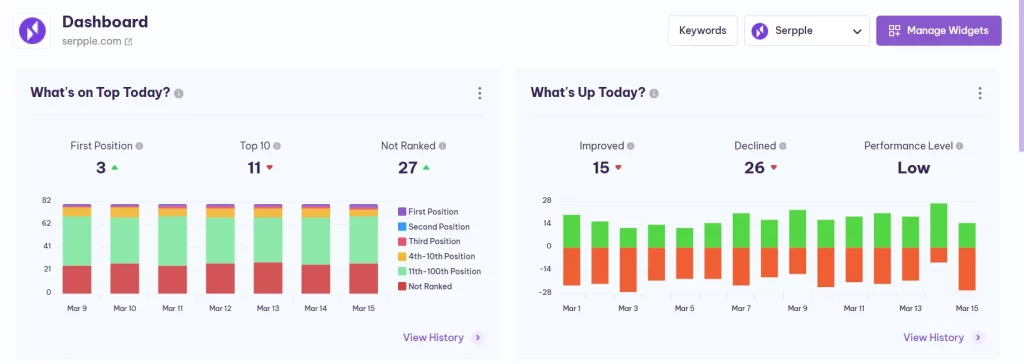
The dashboard also notifies you of search impressions increase (if any) plus the keyword cannibalization issue.
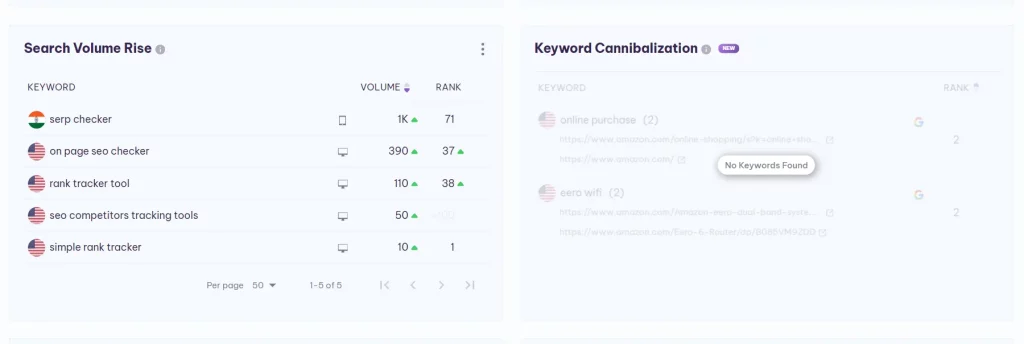
There are a lot of other features that you can explore. Serpple is an intuitive, easy-to-use rank tracker that gives you pinpoint accuracy of your keyword rankings.
To start adding your keyword, you have to add your domain to the tool, which you can do it from the dashboard.
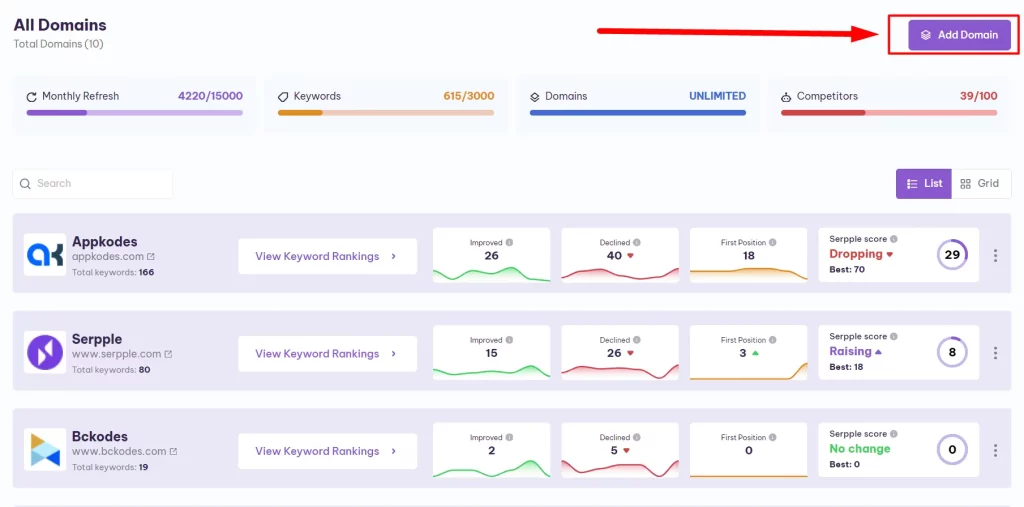
Once, added, you can select your domain, to add keywords in it. For the sake of this blog, I will add some keywords in Serpple.
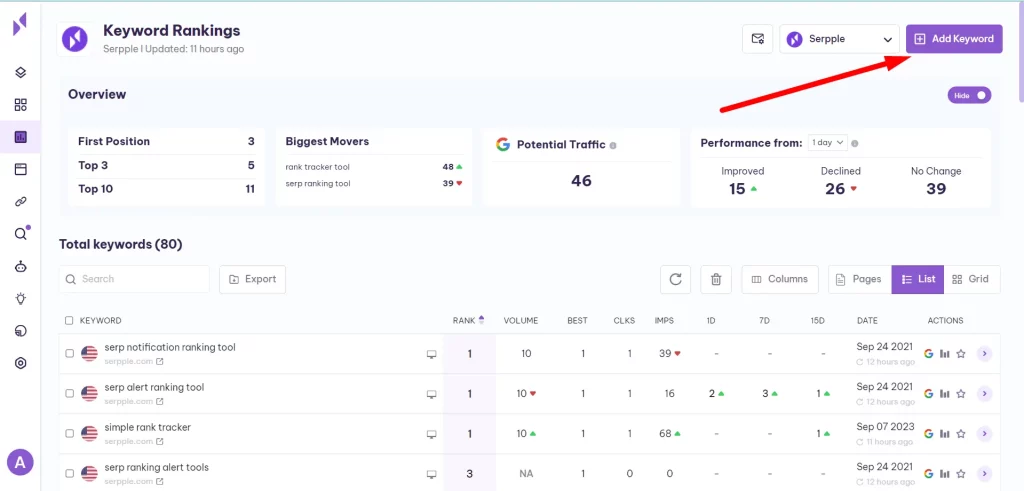
Fill in all the necessary info needed, with the keywords you would like to track.
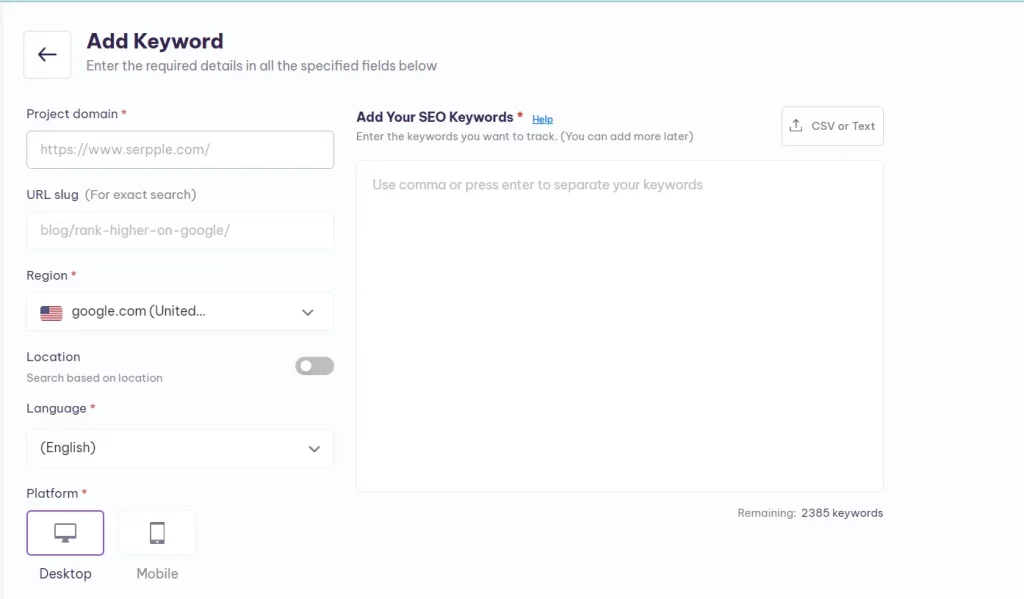
Bonus section
Leverage Reddit, Quora, and Online Forums for Keyword Insights
When starting out, one of the most valuable keyword research tactics is to go directly to the source – your target users themselves. Online communities like Reddit, Quora, and niche-specific forums provide a goldmine of insight into the actual pain points, questions, and topics that resonate most with your audience.
By observing the types of posts, queries, and discussions happening in these spaces, you can tap into the long-tail keyword opportunities. These platforms reveal the precise vocabulary, phrasing, and contexts that your users gravitate towards.
For example, if you offer marketing software, browsing the /r/marketing or /r/DigitalMarketing subreddits on Reddit could unveil frequently discussed struggles around campaign management, analytics, automation, and more. You can mine these for long-tail seed keywords to build content clusters around.
Similarly, monitoring your industry’s top Quora topics illuminates the common questions and knowledge gaps where your content could provide guidance. The phrasing of up-voted questions makes for excellent long-tail keyword incorporation.
The key is to immerse yourself in these communities, note the themes and specific terminologies members use, and model your keyword strategies and content topics around addressing those real-world matters. Create the type of material you wish you had found when frequenting those spaces yourself.
Repurpose content for social platforms
When you first publish a new piece of content, it can take search engines some time to properly crawl, index, and rank those pages – especially for a newer website. Rather than waiting idly, you can accelerate incoming traffic by repurposing and distributing that same content across relevant social media channels.
Look through the headings, subheadings, tips, and key points within your blog posts or guides. Each of those sections can potentially be reimagined as individual social media posts tailored to each platform’s native format and audience.
For example, from this SEO content piece alone, you could create:
- Bite-sized Instagram or Twitter posts highlighting quick tips like “How to Find Long-Tail Keywords” or “Track Your Keyword Rankings Easily”
- Longer posts or story series on Facebook or LinkedIn going deeper into topics like link building or page speed optimization
- Visually-rich carousel posts or Reels breaking down concepts like content planning or using structured data, with scripting support from Chat GPT apps
The options are endless for slicing up and repackaging your authoritative content in creative, engaging ways designed to capture attention on each unique social feed.
Not only does this put your expertise in front of new audiences, but it also allows you to determine what specific topics and angles resonate most based on engagement data. You can then double down on those successful content themes that move the needle.
So while working towards long-term SEO goals, don’t let that content optimization go to waste before it ranks. Maximize that upfront investment through strategic content repurposing for social media distribution.
Maintain a Shallow Website Architecture with Maximum 3 Crawl Depths
While not a make-or-break factor, it’s generally advisable to keep your website’s architecture relatively flat, with no page being more than 3 clicks away from the homepage. Maintaining this shallow crawl depth provides several advantages:
Crawler Efficiency Limiting paths to 3 clicks or less allows search engine crawlers to access and index your entire site more efficiently. The deeper your content is buried, the more computation resources crawlers need to expend, which can potentially lead to some pages getting unintentionally de-indexed or missed.
Improved User Experience: A flat architecture with minimal clicks makes it easier for users to navigate and discover all areas of your website intuitively. Getting disoriented deep into subdirectory rabbit holes frustrates visitors and increases bounce rates.
Crawl Priority Pages closer to the root directory tend to be crawled more frequently and given greater priority by search engine algorithms. This impacts rankings for deep pages that are difficult to reach.
Internal Linking Structure with fewer subdomains and subdirectories, you can focus on internal linking in a more concentrated, strategic way to consolidate ranking signals to important pages.
While not a rigid requirement, auditing and restructuring your site to limit crawl depths to 3 levels maximum is a worthwhile optimization. It streamlines access for both crawlers and users while allowing you to better control internal linking prioritization.
For existing expansive websites, a well-planned restructuring following sound information architecture principles can be invaluable. And for new sites, designing a shallow, efficient navigational structure from the start prevents complex sprawl down the line.
Develop a Free Tool to Provide Value and Drive Relevant Traffic
People love free, helpful resources – especially tools that instantly solve a problem or satisfy a need they have. By creating a free tool related to your products, services or industry expertise, you can attract a steady stream of interested visitors to your website.
The key is developing a tool that genuinely resonates with and benefits your target audience. Going back to our hypothetical cat food business example, you could create a free online calculator that helps pet owners determine the ideal dietary needs and nutritional intake for their cat based on factors like weight, age, activity level, etc.
Not only does this tool deliver immediate value by answering a common query, but it also positions your brand as a trusted, authoritative resource on the subject of cat nutrition and wellness. You’re showcasing your deeper understanding while fostering goodwill.
If built with the proper formatting and keyword optimization, such a tool can also attract consistent traffic from people searching for related terms like “cat food calculator,” “feline diet planner” and so on. Strategically placed calls-to-action can then convert some of those visitors into customers down the line.
For those on WordPress or other CMS platforms, tool scripts, and code can often be purchased affordably from marketplaces like CodeCanyon to expedite development.
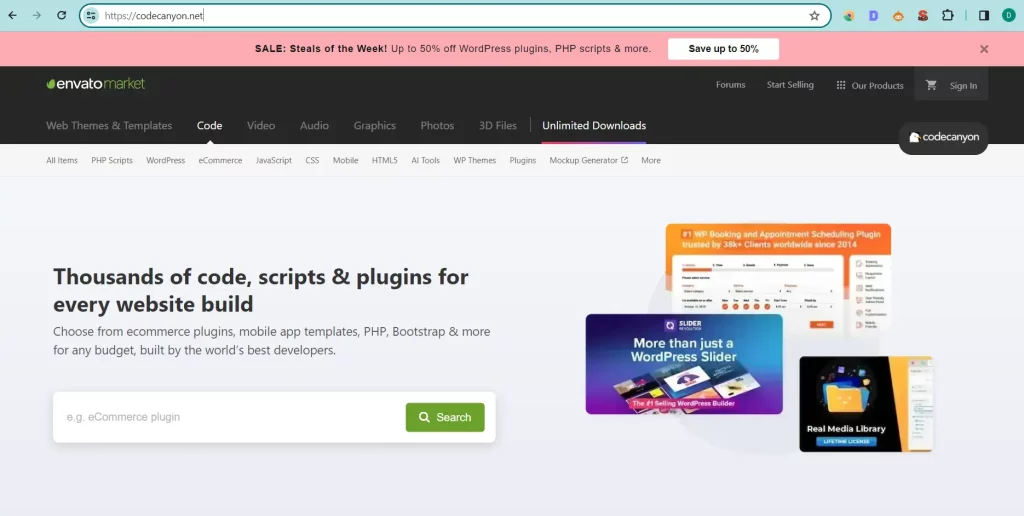
Free tools serve the dual purpose of helping your audience solve an issue while raising brand awareness and authority in the space. It’s an excellent way to generate relevant traffic, build credibility, and nurture potential leads through the power of exceptional utility. With the right utility and promotion, it can become an invaluable asset.
Final Take Away
Improving your website’s search rankings and visibility is an ongoing process that requires a continuous approach. By following the strategies and tips outlined in this guide, you can lay a solid foundation for sustainable SEO success – even as a beginner.
However, it’s crucial to avoid any shady, manipulative “black hat” techniques that go against search engine guidelines. With algorithms becoming increasingly intelligent at detecting spam and low-quality content, such underhanded tactics will only undermine your efforts in the long run.
The key is to adopt a user-focused, “white hat” SEO mindset centered around producing genuinely helpful, high-quality content that enriches the viewer experience. As search engines continue refining their ability to evaluate content relevance and value, this ethical approach will remain evergreen and future-proof.
There’s no shortcut to overnight rankings success. However, a consistent commitment to white hat SEO principles that uphold an outstanding user experience will pay exponential dividends over time. Stay dedicated to adding substantive value, and sustainable organic traffic will follow.
I'm Adam and I've been where you are
I understand the struggle of trying to get SEO traction when you are a small business competing with bigger companies.
That’s why I acquired Serpple. I wanted to provide an affordable tool to small businesses that would help you get the SEO help you needed.
Want to see how Serpple can grow your business?

Benefits of Serpple

More free traffic from SEO
With accurate rank tracking and actionable SEO tools you’ll make better decisions that will fly your website up the rankings!

More money In your pocket
Serpple is 6 SEO tools in one but at a price that is so much less than all of our competitors. You’ll save money every month!

Predictable business growth
As your pages climb up Google’s rankings you’ll get consistent growing traffic which will translate into more leads and customers.
Testimonials

Bryan Vorkapich
"I'm obsessed with checking my rankings every day on Serpple."

Miklos Sakoulas
"An Awesome Tool! It is so easy to track search ranking belonging to your keywords."

Jason Sampson
"Best affordable rank tracking tool around!"



How it works

Step 1: Start your free trial
Start your no-risk 14-day free trial to see if Serpple is right for you.

Step 2: Enter website info
Add your website and keywords into Serpple to get instant access to your rankings.

Step 3: Watch rankings grow
Use our SEO tools to make changes to your site and watch your rankings grow.
Serpple Features
- Rank tracker with daily updates
- Backlink monitor tool
- Keyword Research tool
- Track Unlimited Domains
- Ranking Reports
- Competitor Tracker
- Content Audits
- More tools coming soon
Ready to get started?
Published by
Adam White
Adam White is a 20+ year SEO professional who has optimized over 400 websites, built and sold over 20 internet and SaaS businesses all with SEO as the main traffic source. Follow him on Twitter/X
All stories by Adam White



Pingback: Best Practices for Building SEO-Friendly Landing Pages
Pingback: How to build Brand Awareness through SEO?
Pingback: Top Marketing Tips for Small Businesses: An Ultimate Guide
Pingback: 10 Tips for Boosting Page Speed in 2024